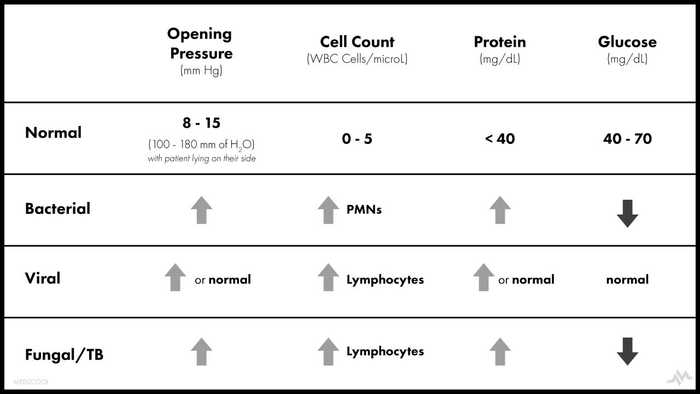NUCLEOTYPE
Cerebrospinal Fluid Analysis in Meningitis
January 10, 2020
Meningitis is inflammation of the leptomeninges, which is the connective tissue surrounding the brain and spinal cord. There are different causes of meningitis: bacterial, viral, and fungal. It a common infectious cause of death and is responsible for approximately 135,000 annual deaths worldwide each year.
Patients usually present with fever, nuchal rigidity (stiff neck), and altered mental status or confusion.
Diagnosis is usually made by lumbar puncture and CSF analysis.
Viral Meningitis
In patients with viral meningitis, you can typically find:
CSF white blood cell (WBC) count in the CSF is usually less than 250 cells / microL. You can almost certainly find that WBC count in viral meningitis is almost always less than 2000 cells/microL. Of these WBCs, you will likely find a majority of them being lymphocytes. CSF protein is usually less than 150 mg/dL. In fact, CSF protein concentrations greater than 200 mg/dL suggest that a viral etiology is unlikely [1]. CSF glucose concentration is typically elevated to more than 50 percent of serum concentration. However, in some viral causes of meningitis, you can see lower CSF glucose concentrations, such as in herpes
Bacterial Meningitis
In patients with bacterial meningitis, you will typically see:
CSF WBC count greater than 1000 cells/microL. Unlike viral etiologies of meningitis, in bacterial causes, you will see a neutrophilic predominance on CSF analysis. CSF protein concentration will be above 250 mg/dL, and CSF glucose concentrations are usually lower than 45 mg/dL.
References
Spanos A, Harrell FE Jr, Durack DT. Differential diagnosis of acute meningitis. An analysis of the predictive value of initial observations. JAMA 1989; 262:2700.
